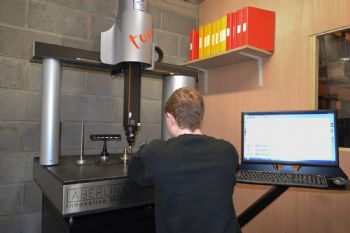
Based in Kirkcaldy, Sterling Precision Engineering Services is a supplier of machined components to the oil and gas and aerospace sectors — plus others.
That said, oil and gas work accounts for most of the company’s output, although a policy of diversification into other sectors— instigated by owner John Mitchell — has insulated it from the worse effects of the slump in the oil and gas sector.
The company’s increased output of high-precision complex aerospace components began to place a strain on its inspection department; and while its inspection staff have access to a wide range of precision instruments, the manual nature of these meant that an inordinate amount of time was being taken to inspect intricate parts featuring exacting tolerances.
Mr Mitchell decided to buy a CNC co-ordinate measuring machine (CMM) that could automate many of the company’s measuring routines.
He said: “To ensure that our policy of broadening the range of industrial sectors that we serve succeeds, we have invested in machine tools that are appropriate to our expanded customer base.
Indeed, we have actually grown our business in the past couple of years and are manufacturing larger volumes of complex high-precision parts — hence our need to automate our inspection functions with a medium-capacity CNC CMM.”
After comparing several makes and models, Mr Mitchell decided that the CNC version of the Axiom Too from Aberlink Ltd, Gloucestershire (
www.aberlink.co.uk) suited Sterling Precision’s needs.
“As our production volumes of high-tolerance components are increasing, the high-precision specification of the Axiom Too and its ability to rapidly inspect multiple parts in automatic CNC mode were major factors in our choice.
“Following a short Aberlink training course, our operators soon became competent in our new CMM’s operation. Now, we can quickly measure and verify the adherence to specification of first-offs before embarking on a production run.
Also, when we manufacture repeat batches, we can quickly recall the relevant pre-written program, load a completed batch of multiple parts and activate a rapid automatic-inspection routine. If required, the Axiom Too can produce a detailed inspection report related to the status of each component in the batch.”
Variant options
The Axiom Too CMM, which is available in both manual and CNC variants, is described by Aberlink as the ‘complete inspection centre’. Designed to be used in both controlled environments and shopfloor conditions that are less
than perfect, the machine features an aluminium bridge with a very low thermal mass.
The use of this lightweight material also minimises inertia, allowing the machine to operate at relatively high speeds.
Furthermore, the CMM’s component support is made of an advanced granite/aluminium honeycomb structure that provides natural damping qualities and further improves the machine’s thermal properties.
Despite the Axiom Too’s measuring volume of 640 x 600 x 500mm (optionally 640 x 900 x 500mm), the machine occupies a relatively small footprint, with the controller and all peripherals housed in its ‘workbench’.
The Axiom Too uses Aberlink’s own 3-D software, which offers a number of novel features. For example, Feature Predict allows the user to take measurement points, leaving the software to automatically determine if a plane, line or circle feature is being measured.
As the user moves from feature to feature, the software predicts what is being measured; and as a component is measured, a picture of it is built up on the screen. The user simply clicks on the measured features to call up dimensions exactly as they would appear on a drawing.
Inspection reports can be in the form of fully dimensioned graphical representations as created on the screen, or tabulated reports in various formats that can show nominal dimensions, tolerances, errors, pass/fails and geometric
tolerances. These reports can also be output to an Excel spreadsheet.
Further reports are available to show the form of features (such as roundness and straightness), hole or point positions, or complete batch results on one report (the user’s company name also appears on all outputs).
Moreover, every time a component is inspected, a programme for measuring subsequent components is automatically created. The software also calculates ‘safe’ moves between features, even when the probe is indexing.